In 2024, there aren’t many things beyond a computer which are compulsory if you want to set up any kind of studio for audio production, but along with a pair of headphones, and an external audio interface, a pair of loudspeakers suitable for monitoring your audio are pretty much mandatory. With the list of non-negotiable essentials being as short as it is, it’s worth getting it right and in this article we’ll examine what you should be looking for in a pair of monitors for your studio and why.
How are monitors different from consumer speakers?
If you are setting up your first studio, you may well wonder why you can’t just use the system you have at home which you use for listening to music? It’s a good question and like most people as old as me, my first ‘studio’ was a four track and my bedroom hifi and my principal reason for using them was so that more than one person could hear the music without passing the headphones around the room. So it does beg the question. Why do we have special ‘monitor’ speakers at all? Are they really that different?
The difference isn’t one of cost or quality.
It’s possible to spend a great deal of money on high-end hi-fi speakers, in some cases more than you’d spend on professional monitoring. While the hifi and pro worlds occasionally overlap, there are two principal differences between speakers designed for consuming music and speakers designed for producing music. The first is voicing.
The design goal of a loudspeaker designed for listening pleasure is to make music sound as good as possible. A studio monitor is designed to represent the audio in as accurate and neutral a way as possible. These two design goals overlap to some degree in that both require distortion-free, full bandwidth reproduction from the deepest bass to the highest treble, but if a hi-fi speaker is deliberately voiced to flatter the music by emphasising a particular region of the spectrum, as long as the result sounds ‘nicer’, then that speaker is improved for its intended use. This differs from a studio monitor in that the sound of the monitor influences the decisions made at the mixing and mastering stages of production, and making those decisions based on a response that deliberately emphasises or attenuates any part of the spectrum will result in less predictable results when played out in the real world on playback systems of varying quality.
This requirement for a flat neutral frequency response is well understood. A second requirement, which is sometimes less well understood is the necessity for extended headroom and system protection. When streaming music, playing back broadcast, material or playing CDs or vinyl, this material has a restricted dynamic range compared to the raw, unprocessed sounds which are likely to be encountered in a studio. The difference between the quietest and loudest sounds encountered by a consumer are significantly less than those encountered when recording live sources through a microphone, or even from electronic sources. A greater potential for damage exists and good quality monitors are designed with this in mind. As well as the physical construction of the drivers, many feature electronic protection to limit the damage which can be caused by unexpected and unpredictable signals hitting the drivers.
A bit of history
The variety, quality and value for money offered by studio monitors today is greater than it’s ever been. Much of the discussion around studio equipment holds the best quality vintage equipment of decades ago in high regard. Old microphones, mixing consoles and outboard equipment are seen as the pinnacle of design by many. But the same cannot be said of monitoring which has improved demonstrably over the decades and the best monitors of years ago cannot compete with modern offerings on technical performance.
In the very early days loudspeaker monitoring existed principally to check for technical faults, like buzzes and intermittent signals. The frequency response of very early speakers was poor. The first monitor speaker which was valued for its accuracy, was the Altec 604, versions of which stayed in continuous production from 1944 until 1998, an astonishing 54 years!
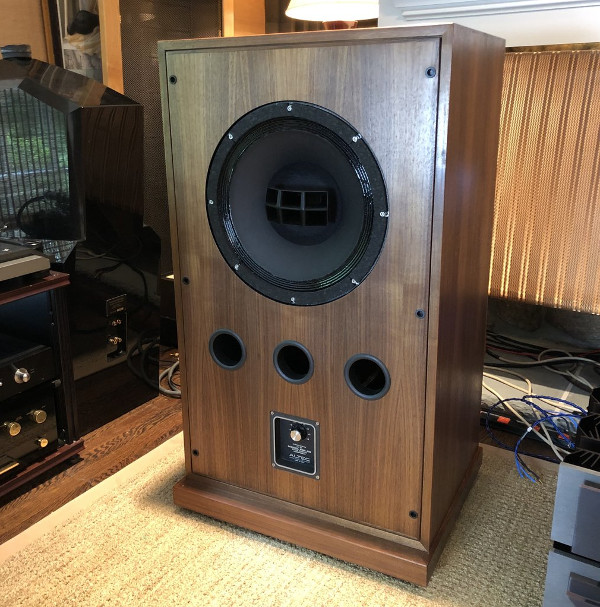
Recording studios commonly featured large main monitors which were designed as part of the control room and built into the walls, known as ‘soffit-mounting’. But these were frequently complemented by pairs of small speakers designed to give an alternative, and more real-world, perspective on the music. Small, single driver Auratones became a common sight during the 1970s and during the 1980s the Yamaha NS10, a two-way speaker with a distinctive white speaker cone, became popular as an addition to main monitors. This was originally a hifi product, which flies in the face of the commonly accepted requirement for a successful monitor loudspeaker to be flat (it was not) and to be specifically constructed for studio use. But it was popular and did much to promote the use of small, free standing two way speakers, fundamentally identical to hifi speakers, as ‘nearfield’ monitors.
Near Field Monitors
Near field monitors are speakers which are used in the acoustic ‘near field’, a region close to the speakers at which the direct sound from the speakers is louder than the sound which has been reflected off one or more surfaces before reaching the listener. Typically mounted between 1 and 2 metres from the listener, this approach reduces the influence of the room’s acoustics making it particularly suitable for home studios with less than ideal acoustic characteristics. Near field monitors in studios are overwhelmingly the most common approach in studios today. Larger monitors, often described as mid field are often found in larger rooms but the large, soffit mounted main monitor is increasingly rare these days.
Active Monitors
In the 1990s the previously unusual approach of building amplifiers into the speaker rather than using an external amplifier became much more widespread. This use of ‘active’ rather than amplifierless ‘passive’ monitors has since become the default approach for most studio monitoring. The advantages are that since the amplifiers and drivers in a monitoring system influence each other’s performance, taking this approach means that they can be designed together and perform optimally. There are also advantages advantage in the design of the crossover network used to divide the frequencies between the different drivers and since the new generation of lightweight, powerful and inexpensive Class D amplifiers have matured, many of the downsides of this approach have reduced. Passive monitors are still useful in some environments like immersive monitoring or for very large systems but if you’re choosing a set of monitors for a home or project studio they are overwhelmingly likely to be active.
DSP
Since the move towards active monitoring another significant development has been the increasing use of DSP in monitors. In a similar way to how active monitoring brought advantages in crossover design, creating the necessary filters digitally brought flexibility, better consistency and often reduced cost. But with the inherent flexibility of digital processing in DSP features such as on-board speaker calibration, allowing complex filtering to be used to match the performance of a monitor with the room in which it is being used has become increasingly common.
Virtual Monitoring
Moving into the second quarter of the 21st century a rapidly developing, and improving area of studio monitoring is in virtual monitoring – creating virtual loudspeakers in virtual rooms, all delivered via headphones. You might wonder why headphones aren’t already the answer to many of the issues around studio monitoring. After all, the room in which people work inevitably influences the performance of speakers, and usually negatively. Using headphones bypasses the sound of the room. Headphones are an important part of studio monitoring, particularly as so much more music is consumed on headphones now that streaming via mobile devices is so ubiquitous, but headphones bring their own set of issues and using loudspeakers as well as headphones is almost universally recommended.
Being able to accurately create the experience of listening to speakers in a room using a binaural rendering has always given unpredictable results because the specific cues which have to be accurately recreated in the headphones are specific to our unique physiology. The combination of ear shape and even the shape of the shoulders and torso all affect the results. They can be measured and reproduced in a Head Related Transfer Function (HRTF) and this has been incorporated into the best of the current generation of products. Generic HRTFs are available. These are what is used to create binaural mixes of Atmos and Apple Spatial content on streaming platforms, but a more convincing effect can be gained using a personalised HRTF based on the specific physiology of the listener.
Two ways virtualised monitoring are used is either to recreate the experience of mixing in a virtual studio control room, a good example of this is Waves’ Abbey Road Studio 3, which places the user in the control room of the famous studio in Abbey Road favoured by Pink Floyd among others. A second use is to create a virtual immersive monitoring system for mixing in formats like Dolby Atmos. The best of these are very convincing. For example I’ve used Applied Acoustics Laboratory’s Virtuoso plugin and while the opinion among Atmos mixers that you have to at least check an Atmos mix on real Atmos monitoring at some point, the virtual option is a fantastic one for people experimenting with the format for whom Atmos monitoring is too much of a barrier to entry, or for any mixers who need to work out of the studio.
With that overview of key developments in monitoring over the years we’ve introduced a lot of issues, but returning to the key point of this article, how much should you be spending on your monitors and what do you need for your purposes?
How much should I spend?
Like most questions, it depends. The Law of Diminishing Returns is very much in play here, with smaller and smaller gains in performance coming with greater and greater increments of expense. But while it’s possible to spend a great deal of money on studio monitors, there has never been a better time to get really great value studio monitoring. The first piece of advice would be to consider your studio and what it needs to do the work you do now, and hope to do in the future. The room and the monitors are one system and there is little point in investing all of your budget in speakers when investing some of your budget in some appropriate acoustic treatment would yield better results.
On the subject of acoustic treatment, comprehensive acoustic treatment is difficult and expensive to do but the same Law of Diminishing Returns that influences monitoring also operates here and modest treatment can yield very worthwhile results. If you are renting your space solutions which don’t damage the walls, or even free-standing treatment products are available, so even if you have a landlord from hell you can still treat your space.
Back to the monitors, you can get exceptional value at the budget end but monitors are electro-mechanical and some important elements like drivers and cabinets will always be relatively expensive, though technology has impacted this. The best advice is to buy something you will keep, and many respected brands offer budget options. As your needs develop and your studio grows you will always find a use for a second pair of monitors and if you decide to sell, a pair of monitors from a well known brand will be more attractive second hand.
This should however be balanced against the fact that there is little sense in spending more than you have to. New brands emerge all the time and some offer amazing value compared to the performance they offer. A great example would be Kali Audio who shook the budget end of the industry up some years ago with their Lone Pine model which offers very respectable performance for under $500 per pair. Other examples of bargains exist, for example Fluid Audio’s FX80, a very different monitor but with comparably capable performance for very similar money. However, while you can get amazing performance for the money, it’s still a fact of file that ultimately you get what you pay for and it’s important not to fall into the trap of thinking that similar looking specifications and positive reviews means that your $500 monitors will sound as good as some $2000 monitors. It doesn’t work like that, though the $2000 monitors won’t sound four times as good – the Law Of Diminishing Returns again!
What features should I look out for in a first pair of monitors?
If you don’t have the budget to buy some proper entry level monitors, don’t buy super-cheap. If you can use what you already have, including headphones, and wait until you can afford what you want then do that. Unlike computers and software, monitors can have a working life of decades. Some of the very cheapest monitors aren’t very different from entry level hifi speakers but are marketed as professional monitors and you’re best waiting if you can of your budget isn’t yet sufficient.
If you look online you’ll notice there are a lot of 2 way active monitors with bass/mid drivers around 6’ in diameter. These are popular for a reason. Offering the best compromise between simplicity and performance, you’ll find great value here. Do be aware that monitors are priced both individually and as pairs. This confuses search results!
Buying quality for the long term has much to be said for it so if you want to keep costs down, rather than buying cheaper large monitors, consider buying smaller, high quality monitors. You will lose out on bass extension and volume but if you add a matching subwoofer at a later date you can rectify this, and its the midrange which is really important anyway. Many people overestimate the importance of bass performance, understandably because ample, deep bass is impressive, but if you are looking for good mix translation most of the difference between a good and a poor mix is in the midrange.
What if I want to upgrade?
It’s natural to want to upgrade equipment when budget allows, and if you’re looking to change your monitors rather than buy a first pair then a couple of questions might help. Firstly, why do you want to upgrade? What don’t your current monitors give you? If the answer is that they don’t sound good enough or your mixes don’t translate well then consider looking at your room as well as, or even instead of, upgrading. This often isn’t the answer people want to hear, but in spite of the fact that installing appropriate acoustic treatment is more complicated than buying new monitors, unless your room has already been properly treated, your current monitors are almost certainly affected by your room at least as much as the difference in sound between your current monitors and whatever you’re considering replacing them with – Sorry…
Do you need more power or low frequency extension? If so consider adding a subwoofer. The advantages of using a dedicated subwoofer is a big enough subject to be an article of its own but be aware that using a well-matched subwoofer (preferably one from the same manufacturer as your monitors) not only delivers more and deeper bass, but because of the work it relieves your monitor of, it can improve the performance of your monitors.
If your reason for upgrading is that you’ve outgrown your current monitors and you want to upgrade to more professional monitoring then make sure you are genuinely moving up rather than sideways. Quality monitor brands as favoured by the pros are great and if you are prepared to pay for it you’ll get better results, but don’t ignore your room and its acoustic treatment. If you upgrade well you can retire your old pair and replace them with something you can keep for years to come.
Can I use room correction software to improve my room?
You’ve probably already noticed that much of the advice given thus far has balanced the contribution of the monitors with the room in which they are being used. This is inescapable, the monitors and the room together make your monitoring system. The frequent references to acoustic treatment is part of that, and dealing with acoustics is often closer to DIY than production and engineering. Isn’t there a quick fix? What about “room correction software”?
More correctly referred to as ‘speaker calibration software’ these products are very clever and genuinely useful but it’s important to understand their limitations. This isn’t a deficiency in the products, it’s just a fact of physics. Speaker calibration software can’t fix ‘nulls’ caused by standing waves in rooms and these are some of the most audible acoustic issues we face. Without getting into the details of this, the most serious issues facing most small studios are in the bass and if you’ve ever noticed how some bass frequencies build up at points in your room and disappear at others, that is a standing wave. Speaker calibration software can’t fix these issues, though they can help to some degree. To fix these standing waves you need bass trapping.
Effective bass trapping is difficult to do well and be aware that thin or lightweight foam products won’t be effective at treating bass. Unfortunately physics dictates that good bass traps are necessarily large and are relatively expensive to build. There are some active products such as the PSI AVAA C20 which are both small and very effective but are not cheap.
Speaker calibration is extremely worthwhile as a complement to adequate acoustic treatment but shouldn’t be considered an alternative to it.
Specific purchasing advice
So far this article has been a general discussion of the considerations and issues facing someone purchasing monitors. A few specific products have been referenced but what about some more specific advice?
So far this article has been a general discussion of the considerations and issues facing someone purchasing monitors. A few specific products have been referenced but what about some more specific advice?
Budget monitors
If you’re looking for a first pair of monitors reviews are useful to tell you about features but keep in mind that comments on how they sound are always subjective and are affected by the room in which the reviewer is listening, what they hear in their room won’t necessarily translate you your room. Also consider the experience of the person sharing their views. The only way to really tell is to hear them in your room, but if you’re buying a first pair of monitors you might not have a great deal of experience to draw on. One thing anyone should notice with a better set of monitors is that mixing becomes easier. You get better at it because you can hear what you are doing better. That’s something everyone should notice even if you’re not sure exactly why it’s happening.
Once you’re away from the extremely inexpensive end of the market it’s hard to buy objectively ‘bad’ monitors. Much of it is about what you like. If there was such a thing as a perfect monitor it would have been found by now. Preference is perfectly legitimate. If you’re uncertain about your choice then check the returns policy before buying.
More upmarket monitors
If you’re buying better quality monitors then consider buying from a pro audio dealer rather than a ‘box shifter’. Some allow auditioning in your studio pre-purchase and some manufacturers sell direct to the public. Brand perception is much more of a factor if you are a pro running a public-facing studio or mastering room so if you feel influenced by brand, there is nothing wrong with that. A friend of mine specifically chose to equip his Atmos studio with a brand of monitors he considered ‘neutral’ in terms of the brand’s perception because he felt choosing either of his other two choices might have alienated fans of the other brand!
At the top end of the market it’s often about balancing personal preference against features. Some high-end brands are overtly technological whereas others are about refining purely analogue approaches which have been with us for decades. Both are legitimate.
What do I have and what would I buy?
I have auditioned and reviewed a lot of studio monitors. Day to day I use Neumann KH310s – I like their compact 3-way design with a large dome midrange and the sealed speaker cabinet gives excellent time performance. As a result these speakers are well known for their ‘dry’ bass. They are analogue-only, so no DSP correction but I run these via an IK Multimedia ARC Studio hardware speaker calibration box.
What would I recommend?
These are comments on speakers I know well. I haven’t tried everything, not many people have, but:
Budget – JBL306P MkII – really great for the money
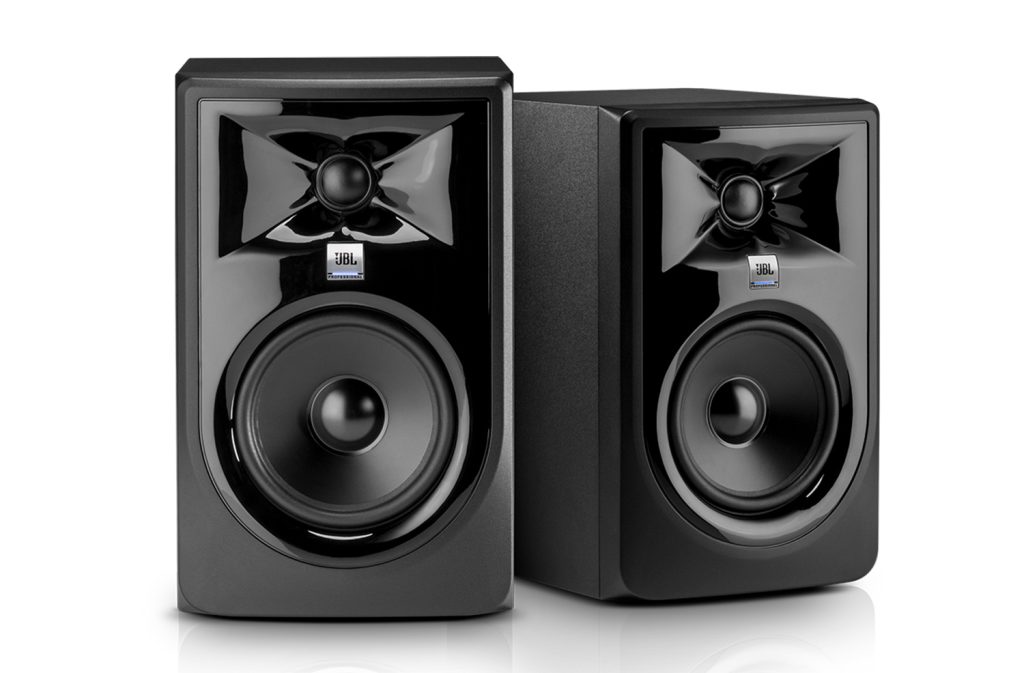
Step Up First Pair – Adam A7V – popular for a reason and network control means they could be useful in an Atmos system if your needs grow.
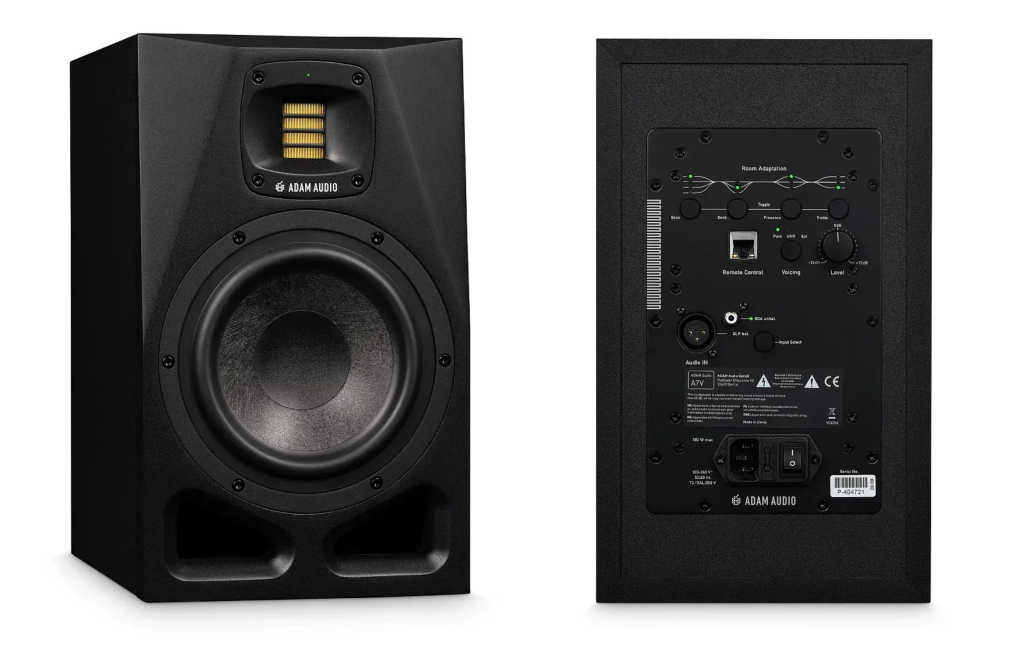
Pro Small Room – Genelec 8341A – Astonishingly great, and tiny. Brilliant on their own but amazing with a Genelec Subwoofer
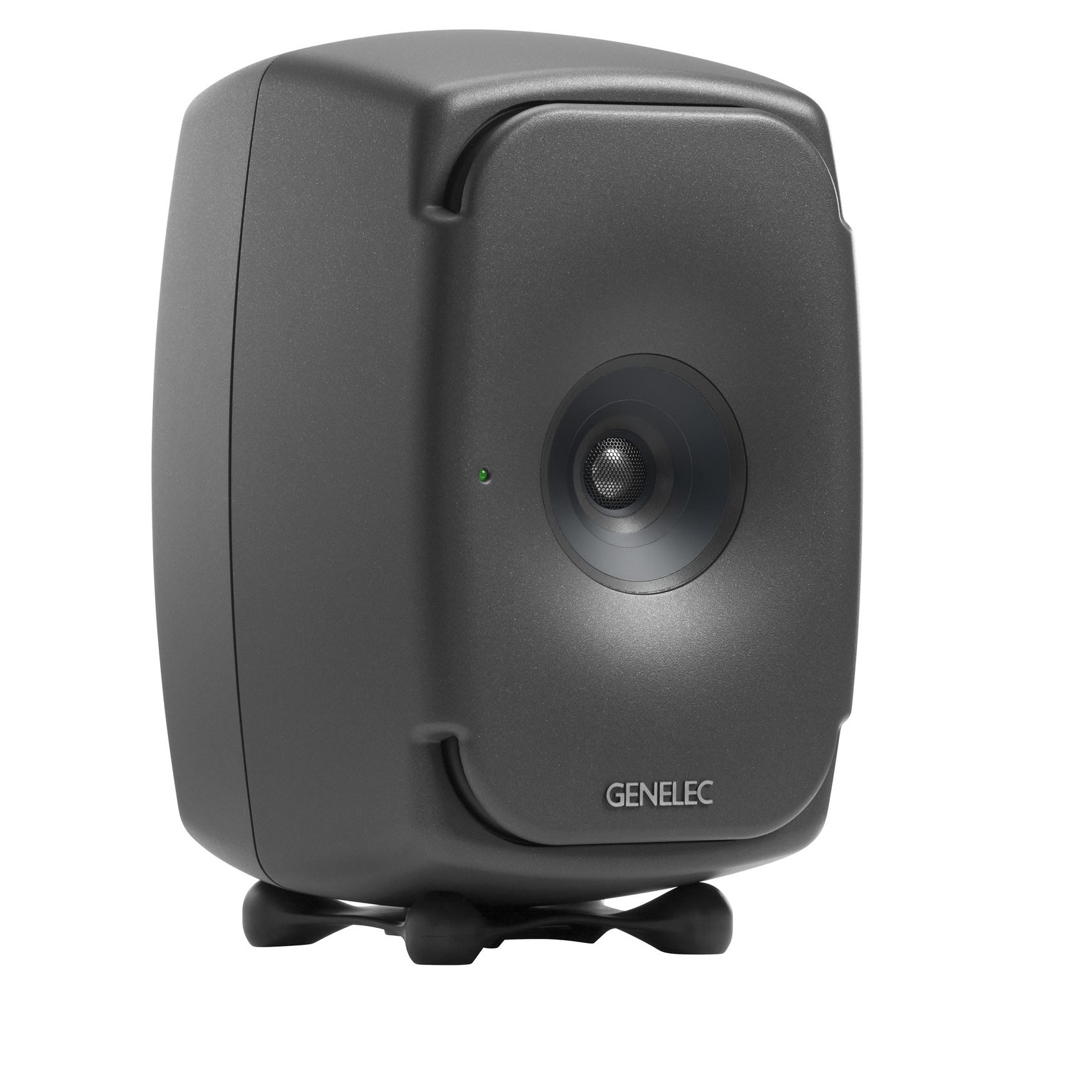
Pro Medium/Large Room – PMC 6.2 – Transmission line excellence, just beautiful
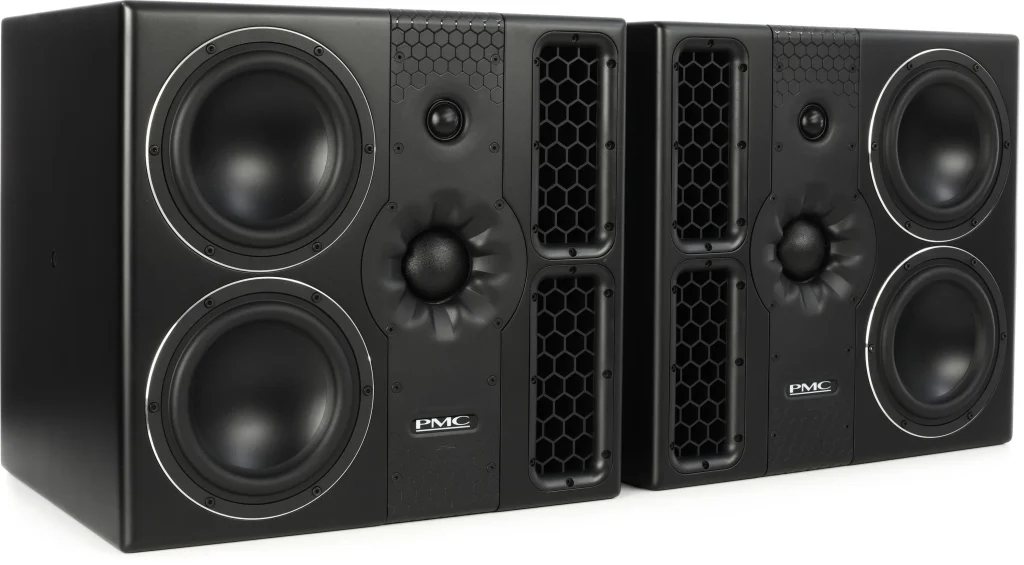
Closing thoughts
Monitors are cheaper and better than they have ever been but you still get what you pay for.
If possible buy the best you can afford and keep them, unlike computers and software, monitors have a potential service life of decades. Every studio can find a use for a second pair of quality monitors.
Remember the influence of your room is probably just as significant as the difference between one monitor and another. Basic acoustic treatment doesn’t have to be expensive but there is a practical limit to how much you can do to a room for a reasonable cost.